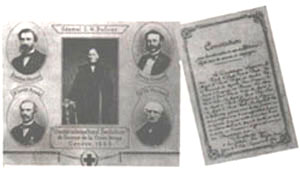
A Convention Is
Signed In Geneva
- For the International Committee, the major task
still lay ahead : persuading government that the
wounded and those caring for them should not be
considerated adversaries, since they were not -
or no longer - taking part in the fighting, and
therefore needed protection. This concept of
neutrality would have to be embodied in an
international treaty providing for a protective
emblem to be used by all armies, to identify
medical personnel, hospitals and ambulances.
- To this end Swii Government undertook to convene,
in Geneva, a diplomatic conference, to be held in
August 1864. Delegates of 12 government took
part. and adopted a draft treaty prepared by the
International Committee.the agreement was called
the " Geneva Convention for the Amelioration
of the Condition of the Wounded in Armies in the
Field.
- This treaty, with its ten articles, was a
milestone in the history of humanity. war andlaw
had, util ten, benn considerated irreconcilable.
The founders of Red Cross argued, however, that
law could apply even during war, and could
regulate, in certain respects, the conduct of
soldiers.
- From then on ambulances, military hospitals and
medicla staff were to be "recognised as
neutral and, as such, protected and respected by
the belligerents... Wounded or sick combatants,
to whatever nation they belong, shall be
collected and care for".
- At the same time the red cross on a white ground
(the Swiss flag reversed), which had been adopted
in 1863 as the symbol of the embryonic Red Cross
movement, was incorporated in the treaty as the
proctective emblem of the military medical
services.
|


![]()
![]()
![]()
![]()
![]()
![]()